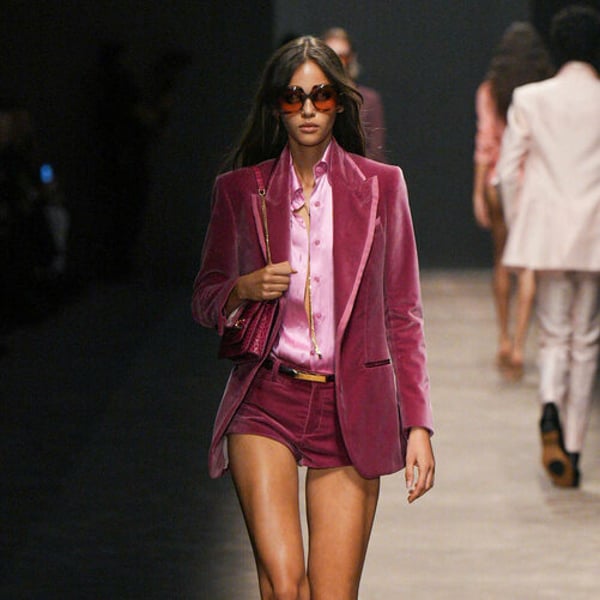By
Bloomberg
Published
Dec 6, 2023
Ermenegildo Zegna NV, Italy’s only fashion house with a New York listing, is looking to the Tom Ford brand to help supercharge expansion in the luxury business.
Tom Ford International, the fashion operation that Zegna Group acquired as other parts of the firm were sold to Estée Lauder Co., “could become one of the 10 most important global fashion brands,” Chief Executive Officer Ermenegildo Zegna said in an interview at company headquarters in Milan.
While that may be a heady goal, Tom Ford overall ranks inside the top 25 in the FashionUnited Index of Most Recognized Fashion Brands, and the Zegna CEO said that’s the kind of exposure that can help his firm, a leader in menswear, to expand in the lucrative accessories segment.
It could also move the needle in womenswear, where new creative director Peter Hawkings’ Milan show earlier this year made headlines with stiletto-heeled models in tight see-through black dresses and bright pink velvet suits.
Now, Zegna wants to double its Tom Ford stores to 100 in the “mid-term,” including openings in Rome and Beijing next year, the CEO said, with a target to increase Tom Ford International’s revenue by over 10% a year.
The 68-year-old Zegna has been the driving force behind his firm’s shift away from traditional mens’ tailored suits to “leisure luxury” lines, including its Triple Stitch shoes favored by corporate luminaries like Tim Cook and Jamie Dimon. The approach is paying off, Zegna said, with a rise in US revenue that he hopes can be replicated in China.
Zegna has spearheaded an aggressive expansion push over the last five years that he says is based on lessons learned from mentor Sergio Marchionne. Zegna spent seven years on Fiat Chrysler’s board while Marchionne was the carmaker’s CEO, and he listened when the boss preached that “scale matters.”
Proudly showing off his company’s latest shoes, Zegna, who goes by the name Gildo, offered up another quote made famous by the hard-driving Marchionne: “Mediocrity is not worth the trip.”
Woolen mill
And the trip has been a dizzying one for the fashion group, a journey that’s taken it from its origins as a humble woolen mill built by Zegna’s grandfather in 1910 to a 2021 listing on the New York Stock Exchange.
In 2018 Zegna made its first major overseas acquisition, buying US brand Thom Browne, known for its modern takes on traditional gray pinstriped suits. The deal, part of a bid to attract younger customers and women, “was like winning a trophy,” the CEO said.
But it’s the April acquisition of Tom Ford International that Zegna sees as the real key to transforming the traditional family-run company into a modern, high-end fashion house.
Links between the two sides date back more than 15 years, and Zegna has worked with designer Ford since he started his namesake business after leaving Gucci, which he revitalized during a decade-long stint as creative director.
Now firmly entrenched on both sides of the Atlantic, Zegna said he sees the link between high fashion and high finance in New York as a natural. “Wall Street is marketing,” the CEO said. “Clients are also investors.”
Asia signs
Recent signs have been less encouraging in Asia, still the company’s most important region for sales.
High net-worth consumers in China have registered a “decline in optimism” since April, according to a report by consulting firm Agility Research & Strategy.
The trend matches Zegna’s recent performance in the region, where China in particular has been lagging, raising questions on “whether the Chinese consumer is not reacting in the same positive way to the rebranding,” UBS analysts led by Susy Tibaldi wrote in a note.
“Getting a message of cultural change to China, which recovered late from Covid, has been taking a bit longer” than in other markets like the US, the CEO acknowledged.
Staying ahead of shifts in trends in Asia, in particular for younger buyers, may indeed prove challenging for Zegna and for other luxury groups, said Stefania Saviolo, who lectures on fashion and luxury management at Milan’s Bocconi University.
“We don’t know yet exactly what young, post-Covid Chinese customers are looking for,” Saviolo said in an interview, adding that this demographic may only know the brand “through their parents.”
Still, CEO Zegna remains upbeat on the prospects in the region, particularly for Tom Ford. “There is still a lot we can do in Asia,” he said.
While the Italian entrepreneur said he doesn’t have the ambition to see his company become a luxury powerhouse able to compete with French behemoths like LVMH, he still sees the firm as an “aggregator of luxury brands,” adding that he doesn’t expect deals to be discussed in 2024.
After that, “our eyes are always open.”







